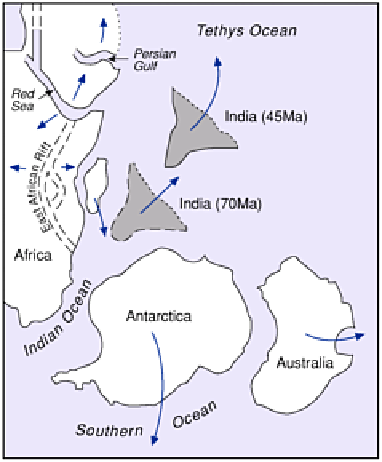Environmental Engineering Reference
In-Depth Information
and the Scotia arc between South America and the Antarctic Peninsula, and the closure of
the Panama seaway linking the Americas, are two further Cenozoic stages in ocean
evolution. The former opened up the circumpolar southern ocean and the latter closed the
tropical Atlantic-Pacific strait. Both events had major influences on Quaternary global
glaciation. The next supercontinent will take shape as Atlantic widening continues and
the Pacific subducts beneath the Americas, whilst Africa rifts apart to create a new ocean.
OCEAN ARCHITECTURE
The dynamic architecture of mid-ocean ridges and trenches, which drive the
supercontinental cycle, covers approximately one-third of global ocean area. Ridges
Figure 11.3
Progressive continental rifting of eastern
Gondwanaland, showing composite motion c. 100-40 Ma
ago. The Red Sea divergent plate boundary and associated
East African-Middle East rifts may mark the birth of a future
ocean.
account for 95 per cent of this and form Earth's principal continuous 'mountains' with
broadly symmetrical, parallel crest-and-trough structures, 10
2-3
km wide and 2-4 km
high. They are offset along transform faults and slope away from the thermal rise at their
central axis, at angles proportional to their spreading rate. Topographic symmetry is
matched by a geomagnetic 'bar code' of bands showing normal and reversed magnetic
polarity. Magnetic minerals in basalt extruded at the central rift assume Earth's magnetic
polarity before cooling and record its reversals over 10
4-6
years. Paired bands, of similar

